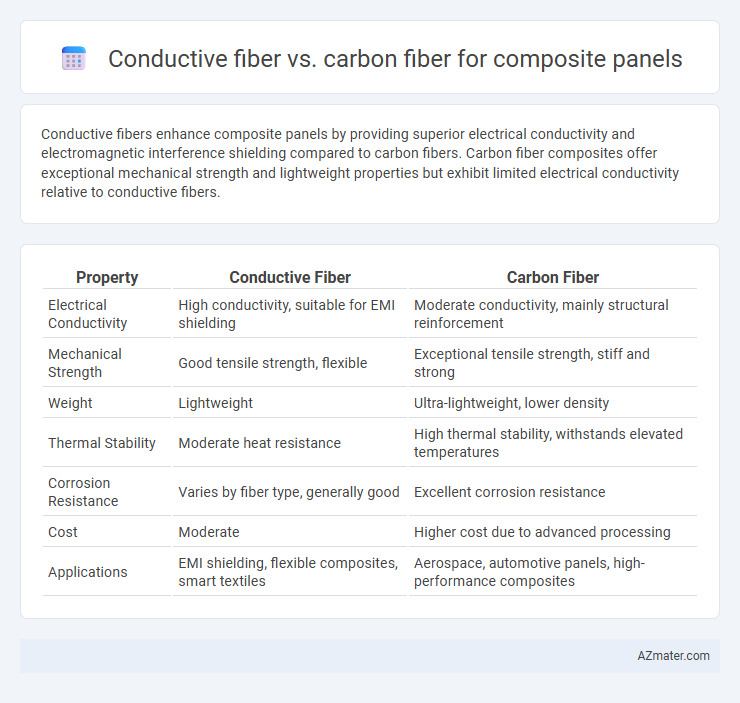Conductive fibers enhance composite panels by providing superior electrical conductivity and electromagnetic interference shielding compared to carbon fibers. Carbon fiber composites offer exceptional mechanical strength and lightweight properties but exhibit limited electrical conductivity relative to conductive fibers.
Table of Comparison
| Property | Conductive Fiber | Carbon Fiber |
|---|---|---|
| Electrical Conductivity | High conductivity, suitable for EMI shielding | Moderate conductivity, mainly structural reinforcement |
| Mechanical Strength | Good tensile strength, flexible | Exceptional tensile strength, stiff and strong |
| Weight | Lightweight | Ultra-lightweight, lower density |
| Thermal Stability | Moderate heat resistance | High thermal stability, withstands elevated temperatures |
| Corrosion Resistance | Varies by fiber type, generally good | Excellent corrosion resistance |
| Cost | Moderate | Higher cost due to advanced processing |
| Applications | EMI shielding, flexible composites, smart textiles | Aerospace, automotive panels, high-performance composites |
Introduction to Composite Panels
Composite panels often utilize conductive fibers or carbon fibers to enhance electrical conductivity and mechanical strength. Conductive fibers, typically made from materials like copper or silver, provide superior electrical pathways ideal for electromagnetic interference shielding and static dissipation. Carbon fibers offer exceptional tensile strength and rigidity, making them optimal for structural reinforcement but with moderate electrical conductivity.
Overview of Conductive Fiber
Conductive fibers, composed primarily of metals like silver, copper, or carbon-based materials integrated into textiles, offer significant electrical conductivity and flexibility advantages over traditional carbon fibers in composite panels. These fibers enable effective electromagnetic interference (EMI) shielding, static dissipation, and sensing capabilities within composite structures, enhancing multifunctionality in aerospace, automotive, and wearable electronics applications. Their integration into composite panels maintains structural integrity while providing superior electrical performance compared to the typically higher stiffness and lower conductivity of standard carbon fibers.
Overview of Carbon Fiber
Carbon fiber is a lightweight, high-strength material widely used in composite panels for its superior stiffness, tensile strength, and corrosion resistance compared to conductive fibers. Its graphite-based structure provides excellent mechanical performance and thermal stability, making it ideal for aerospace, automotive, and sports equipment applications. Carbon fiber composites offer enhanced structural integrity and durability while maintaining a low weight profile, crucial for high-performance engineering solutions.
Key Properties Comparison
Conductive fiber composites exhibit superior electrical conductivity and electromagnetic interference (EMI) shielding compared to carbon fiber panels, making them ideal for applications requiring static dissipation or signal integrity. Carbon fiber panels offer higher tensile strength and stiffness-to-weight ratio, benefiting structural performance in aerospace and automotive industries. Thermal stability in carbon fiber composites exceeds that of most conductive fibers, supporting high-temperature environments where mechanical durability is critical.
Electrical Conductivity Performance
Conductive fibers such as silver-plated or copper fibers exhibit superior electrical conductivity compared to carbon fibers, making them ideal for electromagnetic interference (EMI) shielding and static dissipation in composite panels. Carbon fibers provide moderate conductivity with added benefits of high strength-to-weight ratio and structural reinforcement but have higher resistance than metal-based conductive fibers. Optimizing composite panel performance requires balancing conductivity requirements with mechanical properties, where conductive fibers excel in pure electrical tasks and carbon fibers contribute multifunctionality.
Mechanical Strength and Durability
Conductive fibers in composite panels offer excellent electrical conductivity but typically exhibit lower mechanical strength compared to carbon fibers, which are renowned for their superior tensile strength and stiffness. Carbon fiber composites provide enhanced durability, resist fatigue, and maintain structural integrity under extreme stress, making them ideal for high-performance applications. Conductive fibers may compromise panel longevity due to reduced mechanical robustness, while carbon fibers ensure long-term strength and resistance to wear.
Applications in Industry
Conductive fiber composites are widely used in electromagnetic interference (EMI) shielding and wearable electronics due to their excellent electrical conductivity and flexibility. Carbon fiber composites offer superior strength-to-weight ratios and thermal stability, making them ideal for aerospace, automotive, and sporting goods industries. The choice between conductive fiber and carbon fiber depends on the specific industry application requirements such as electrical conductivity versus mechanical performance.
Cost and Availability
Conductive fiber generally offers a lower cost compared to carbon fiber, making it a more economical choice for composite panels in budget-sensitive applications. Availability favors conductive fibers due to their broader production scale and less specialized manufacturing requirements, while carbon fiber, known for its superior strength-to-weight ratio, remains more expensive and less widely stocked. The higher price and limited supply chain of carbon fiber often restrict its use to high-performance or aerospace-grade composite panels.
Environmental Impact and Sustainability
Conductive fibers, often made from metal alloys or stainless steel, offer recyclability advantages but typically involve high energy consumption during production, impacting environmental sustainability. Carbon fibers, derived from polyacrylonitrile (PAN) or pitch-based precursors, provide excellent strength-to-weight ratios but present challenges in recyclability and require energy-intensive manufacturing processes, contributing to a larger carbon footprint. Advances in recycling technologies for carbon fiber composites and the development of bio-based conductive fibers aim to improve sustainability and reduce environmental impact in composite panel applications.
Choosing the Right Fiber for Your Composite Panels
Conductive fibers offer superior electrical conductivity, ideal for composite panels requiring electromagnetic interference (EMI) shielding or static dissipation, while carbon fibers provide exceptional strength-to-weight ratio and stiffness, making them perfect for structural applications. Selecting the right fiber depends on the panel's primary function: use conductive fibers when electrical performance is critical, and opt for carbon fibers for enhanced mechanical properties and durability. Evaluating factors such as conductivity requirements, mechanical load, weight constraints, and cost efficiency ensures optimal composite panel performance.

Infographic: Conductive fiber vs Carbon fiber for Composite panel
 azmater.com
azmater.com